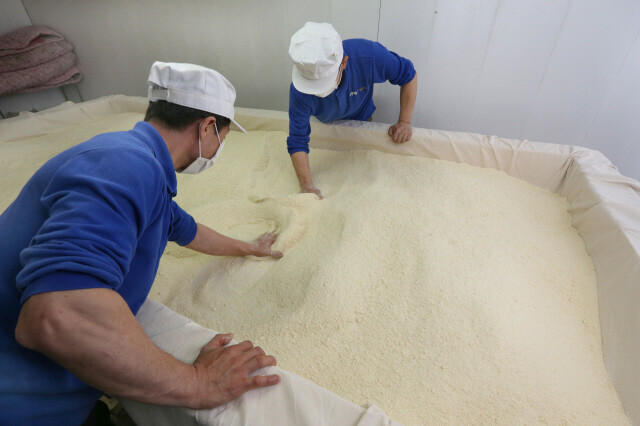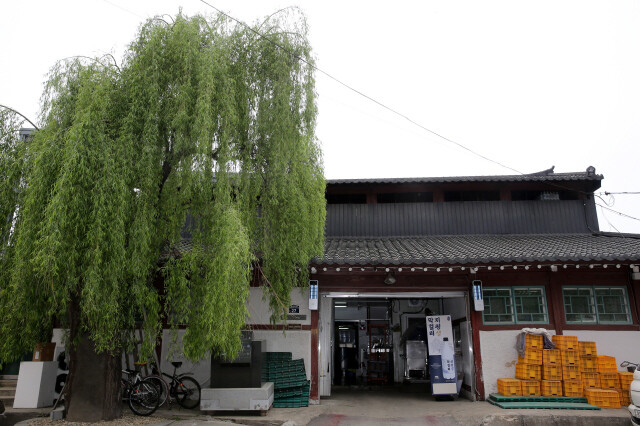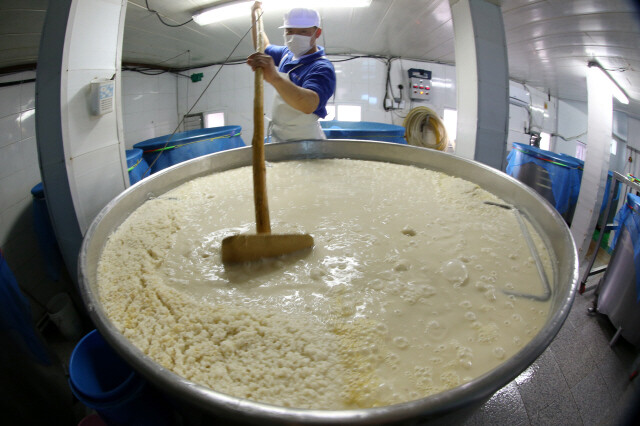hankyoreh
Links to other country sites 다른 나라 사이트 링크
[Reportage] Searching for “pure” makgeolli

Jipyeong Brewery - located in Jipyeong Village, Yangpyeong County, Gyeonggi Province has long been regarded as one of South Korea‘s top breweries of makgeolli, or Korean rice beer. It had taken me an hour and a half to drive there from Seoul, and I parked my car on the side of a narrow country street.
Trucks loaded with makgeolli came and went, and a dozen or so yellow plastic crates were stacked upside down on one side of the brewery. A sprawling willow tree that has been there since the brewery was built during Japanese colonial times (1910-45) was still standing on the other side.
This building (427.7 square meters), a wooden structure in the Japanese style that appears to have been dropped into the middle of a hanok, or traditional Korean house, once served as the headquarters of UN forces. The plaque and memorial stone stating that the building has been designated as a cultural artifact (No. 594) is concealed behind the branches of the willow, which has grown bigger than the building.
When South Korea’s Cultural Heritage Administration announced the designation on July 1, 2014, it described a building that has defied the ravages of time: “This eclectic structure, which created a large space by adding a Japanese-style wooden structure onto a Korean-style wooden base, effectively showed in architectural terms how it functioned as a makgeolli production facility at the time.” Jipyeong Brewery has even incorporated the appearance of the building into its logo.

Jipyeong Brewery’s current building was built in 1939, though the company itself was established in 1925. Nine decades have passed since then. The brewery was bought from its founder by the grandfather of Kim Gi-hwan, the current brewer, and it has been run by the same family for three generations.
Kim is 35 years old this year. Seven years ago, he inherited the brewery from his father. While Kim was born in Jipyeong, he spent most of his childhood in Seoul. After graduating from university and working in marketing, he took over the family business.

A building’s long history seen on its walls
I followed Kim inside. Its old dirt walls have been refinished with modern materials, and despite its outside appearance, the interior looks ordinary.
We headed straight for the last room on the left. With wooden walls, the room was as warm and muggy as a steam bath. Red numbers on the LED screen on a thermometer showed it was 27.8℃. Kim explained that this was the “jongguk” room, referring to the fermenting agent, called jongguk.
“The machines are pretty good at keeping the temperature at the right setting, but we still need to have someone on duty 24 hours a day to watch everything. If the temperature goes above 40℃, the bacteria die,” he said.
Square crates made of Paulownia wood were stacked crosswise, showing their content. The crates were filled with a mash made by steaming rice or wheat, to which jongguk was added. This was where the mold (aspergillus luchuensisis) cultivated, Kim told me.
Through the glass doors, I could see two employees in the next room (called the “wrapping” room) adding ipguk to the rice mash and mixing it with their hands. Ipguk is a type of nuruk (the basic starter used to make makgeolli) that has been sprinkled with jongguk and with steamed rice or wheat. When the mash and the nuruk have been mixed enough, they are covered with a cloth wrapper (this is where the “wrapping” comes from) and left to ferment for a day.
After being brought back to the jongguk room and fermented for another day, the mixture is taking to the fermenting room, where the alcohol fermentation process begins in earnest. By the end of two stages of fermentation in this room, the mixture starts to bubble as if it were boiling. These bubbles are actually air exhaled by the lactic acid bacteria.
It takes about one week from the time that the rice and wheat are steamed until the makgeolli is completed, Kim said.
Coming out of the jongguk room, we climbed a steep wooden staircase on the end to the right and went up to the building‘s ceiling. Rice husks were scattered all over the dark ceiling.
“We maintain the temperature by scattering rice husks on the ceiling and walls of the building. Apparently, there are only a handful of breweries that use rice husks to maintain the temperature,” said a middle-aged employee. The employee said that he had come here six months ago after quitting his job at a beer company.
In the cracks between the wooden frame of the ceiling, I could see whitewashed adobe. The long history of the building could be seen in its frame and its adobe walls.

Should makgeolli have a purity law, too?
On Apr. 23, when the makgeolli was fermenting at Jipyeong Brewery just as on any other day, was the 500th anniversary of Germany’s promulgation of the Reinheitsgebot, or the beer purity law. Germany’s post office issued commemorative stamps, and German Chancellor Angela Merkel attended the Reinheitsgebot festival.
The festival was held in the southeast German state of Bavaria, where the beer purity law was first enacted. Germans believe that the long tradition of German beer - an alcohol produced by fermenting grain, just like makgeolli - was founded on the beer purity law.
The beer purity law restricted the ingredients of beer to water, barley (malt) and hops. If anything else was mixed in, it could not be called beer. This is one of the best-known old laws about food products.
The law was first promulgated on Apr. 23, 1516, by William IV, Duke of Bavaria. The original law declared that if anyone violated the law, the beer in their brewery would be confiscated.
The sixteenth century was a time of urbanization. Consumption of beer was increasing, and brewers were adding fragrant herbs, spices and fruit to beer. Some added poisonous herbs to their beer to increase its alcohol content, while monasteries made wheat beer.
The Duchy of Bavaria needed to stabilize the price of wheat and rye, since these were important foodstuffs, and it also needed to increase its tax revenue.
In later years, when Prussian king William I had united Germany, he extended the beer purity law to the entire country. During the five centuries that they have abided by this law, German brewers have managed to create various beers through the simple combination of this limited set of ingredients. This has also had the effect of blocking the inclusion of harmful additives such as sugar, food coloring and artificial fragrances.
Today, Germany’s neighbors regard the beer purity law as a non-tariff barrier for trade, so the law no longer applies to beers for export and imported beers. While wheat beer was legalized at the beginning of the 19th century, the majority of German brewers continue to follow the beer purity law. The law is the essence of German beer.
At the end of last year, with the 500th anniversary of Germany’s beer purity law on the horizon, South Korea’s Ministry of Agriculture, Food and Rural Affairs announced that it would be implementing a makgeolli purity law. Drawing inspiration from the beer purity law, the plan was to limit government quality certification to makgeolli that was brewed only with domestic rice, fermenting agents and water.
Thus far, the Ministry has provided quality certification even to varieties of makgeolli that contain wheat, sugar or various other food additives. But if the makgeolli purity law took effect, it would mean that any makgeolli that did not meet these requirements would not be able to receive quality certification. This would allow customers to choose between makgeolli that has been certified by the government for quality and makgeolli that has not.
The government’s plan to adopt a purity law is related to the popularity of makgeolli, which has become South Korea’s best-known traditional alcohol. Since the lactic acid in makgeolli is still alive when makgeolli reaches shelves, sales increased amid a healthy eating trend in 2010.
Shipments of makgeolli more than doubled between 2009 and 2011 - jumping from 214,000 kl to 444,000 kl. After that, they dropped to 415,000 kl in 2012 and to 378,000 kl in 2013, but sales appear to have stabilized, with orders back up to 431,000 kl in 2014.
With the increasing popularity of makgeolli, “cloudy sake,” which contains rice solids, has even been sold in Japan under the name “makgeolli.”
To be sure, effort is needed to make clear the identity of makgeolli, just as South Koreans have fought to prevent the fermented cabbage dish known as kimchi from being pronounced in the Japanese manner as “kimuchi” (キムチ). However, there are also concerns that such a measure could wipe out makgeolli‘s diversity.
Even in Germany, it is acknowledged that diverse flavors of beer disappeared after the enactment of the beer purity law. While a variety of additives were used to improve beer’s flavor in countries such as the US, the UK and Belgium, German beer is comparatively plain. And with the expansion of the craft beer market, the beer purity law could already be in trouble.
The Ministry seems to be acting with caution. “At first, we were planning to implement the makgeolli purity law in the first half of this year. But since some people thought that certification categories are needed not just for makgeolli but also for other kinds of traditional alcohol, we’re currently soliciting views from a wide variety of industry representatives and reviewing what the ramifications might be,” said In So-yeong, a Ministry official in the food industry promotion division. “We also think that positive consideration should be given to the question of permitting fruit and other natural ingredients,” said In.

What makgeolli needs
While makgeolli is receiving more attention than it used to, the domestic traditional alcohol market remains tiny. For one thing, the tradition of brewing alcohol at home on a small scale for personal consumption or for sale was snuffed out because of various regulations under Japanese occupation of Korea, including looting, the Alcohol Tax Law and the “limited license system.” And then the shortage of rice caused by the Korean War, drought and political turmoil pushed drinkers to switch to wheat makgeolli and diluted soju. After Western eating habits were adopted following South Korea’s economic growth, beer took the place of makgeolli.
A 2014 fact-finding survey by the Ministry found that there were 569 makgeolli breweries in the country. If alcohols that are characterized as traditional (including cheongju, yakju, fruit wines and distilled soju) are added to the total, the number of breweries rises to about 850. [Cheongju and yakju are clear rice wine and refined rice wine, respectively.]
Half of these breweries are small businesses with less than 100 million won (US$86,700) in yearly sales. Since makgeolli has a short shelf life, brewers have no choice but to rely on the local market. As time goes by, the gap is widening between breweries based in Seoul and other big cities and those in more rural areas.
“Breweries in the countryside get their revenue from the local market, which makes them particularly sensitive to prices. The Agriculture Ministry wants them to use locally grown rice, but if the wholesale price suddenly spikes, retailers will riot. That’s how hard it is to break out of small-scale brewing,” said Lee Su-jin, president of Sulfun, an online platform for marketing traditional alcohol.
“Down the road, the makgeolli market will no doubt move toward premium quality, but for brewers to develop new products, there needs to be some kind of standard, such as building joint brands and finding joint outlets for sales. Now is not the time to force makgeolli into a regulation straitjacket,” Lee said.
There are others who argue that a makgeolli purity law could be taken as an opportunity to create keywords that would illustrate makgeolli’s distinctive qualities and diversity. Instead of product names, the idea is to institute a kind of ranking system that would enable customers to easily identify ingredients and quality, just as with wine or sake in Japan.
With sake, grades and categories are determined according to what percentage of the rice in the sake has been milled. Premium sake Junmai Daiginjo is made with highly polished rice with no added alcohol, Daiginjo is also made with highly polished rice but adds alcohol, and Junmai Ginjo is made with less polished rice and no added distilled alcohol.
“Customers aren’t able to distinguish [different kinds of] makgeolli,” said Heo Shi-myeong, president of Sool School. “Makgeolli can have various flavors and qualities depending on whether the rice is domestic or imported, whether the rice was harvested this year or not, what variety of rice was used, whether sweeteners are included, what the fermentation period was and whether the cold fermentation or the forced fermentation process were used. But there are no keywords that can easily convey such information. In a situation such as this, the cheapest makgeolli wins out in the end.”
It will also be interesting to see how the newly established license for small-scale makgeolli, yakju, and cheongju producers will affect the traditional alcohol market. In February, the government revised the enforcement decree of the Liquor Tax Act, lowering the minimum production capacity for traditional alcohol licensing from 5 kl to 1 kl. This makes it possible for restaurants to sell craft makgeolli they have made themselves on premises.
“It’s now possible for extremely original kinds of alcohol to be made in small quantities,” Heo said. “This means that alcohol can be consumed like some kinds of food that are made in limited amounts and that provide a distinctive taste, instead of being mass produced and supplied in bulk. Makgeolli used to be a drink that was made at home just like kimchi, doenjang and gochujang, and now it’s back in our kitchens.”
[Doenjang, or fermented soybean paste, and gochujang, or red pepper paste, are two distinctive Korean condiments.]
Another encouraging sign is that young people have recently started to get onboard the brewing industry. There are more examples of young people who got a taste of the potential of the fermented food business during the makgeolli boom in 2010 and are now inheriting the family business. One example is Kim, the head of Jipyeong Brewery.
People like Kim are devoting time and effort to developing and marketing new products. They are breathing new life into the brewing industry, which needs distinctiveness and diversity. There are already 50 “alumni breweries” that are operated by graduates of Heo’s Sool School, which was set up in 2009. Brewers‘ sons, younger siblings and daughters-in-law are visiting the school to learn the skills of the trade.
“Beer is a good example of a drink that succeeded in its turbid form in the West - which is a ’barley cultural sphere’ - and became clearer through its globalization process,” Heo [or however it’s spelled] said. “Makgeolli could well represent the East, which is a rice cultural sphere.”
“It’s rare that you find a drink becoming its country’s representative alcohol when it’s distributed with live lactic acid bacteria,” he noted. “We’ve only just begun developing and differentiating high-end makgeolli varieties. Soon, the quantitative growth is going to bring about qualitative changes.”
By Park Ki-yong, staff reporter
Please direct questions or comments to [english@hani.co.kr]

Editorial・opinion
![[Column] Season 2 of special prosecutor probe may be coming to Korea soon [Column] Season 2 of special prosecutor probe may be coming to Korea soon](https://flexible.img.hani.co.kr/flexible/normal/500/300/imgdb/original/2024/0426/3317141030699447.jpg) [Column] Season 2 of special prosecutor probe may be coming to Korea soon
[Column] Season 2 of special prosecutor probe may be coming to Korea soon![[Column] Park Geun-hye déjà vu in Yoon Suk-yeol [Column] Park Geun-hye déjà vu in Yoon Suk-yeol](https://flexible.img.hani.co.kr/flexible/normal/500/300/imgdb/original/2024/0424/651713945113788.jpg) [Column] Park Geun-hye déjà vu in Yoon Suk-yeol
[Column] Park Geun-hye déjà vu in Yoon Suk-yeol- [Editorial] New weight of N. Korea’s nuclear threats makes dialogue all the more urgent
- [Guest essay] The real reason Korea’s new right wants to dub Rhee a founding father
- [Column] ‘Choson’: Is it time we start referring to N. Korea in its own terms?
- [Editorial] Japan’s rewriting of history with Korea has gone too far
- [Column] The president’s questionable capacity for dialogue
- [Column] Are chaebol firms just pizza pies for families to divvy up as they please?
- [Column] Has Korea, too, crossed the Rubicon on China?
- [Correspondent’s column] In Japan’s alliance with US, echoes of its past alliances with UK
Most viewed articles
- 1‘We must say no’: Seoul defense chief on Korean, USFK involvement in hypothetical Taiwan crisis
- 2N. Korean delegation’s trip to Iran shows how Pyongyang is leveraging ties with Moscow
- 3‘Weddingflation’ breaks the bank for Korean couples-to-be
- 4Korea sees more deaths than births for 52nd consecutive month in February
- 5[Editorial] New weight of N. Korea’s nuclear threats makes dialogue all the more urgent
- 6[Column] Has Korea, too, crossed the Rubicon on China?
- 7[Column] Park Geun-hye déjà vu in Yoon Suk-yeol
- 8[Guest essay] The real reason Korea’s new right wants to dub Rhee a founding father
- 9Amnesty notes ‘erosion’ of freedom of expression in Korea in annual human rights report
- 10[Reportage] On US campuses, student risk arrest as they call for divestment from Israel